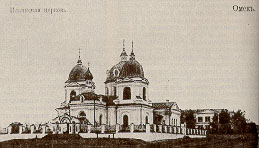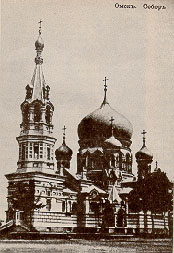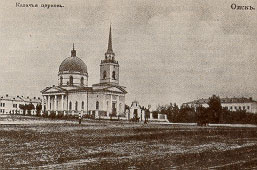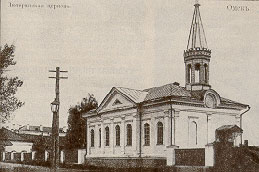

 In a middle of
18 c. in Omsk settlement Ilinskaya church was constructed. In 1759 it had
been transferred on the left coast and put at the walls of an old fortress
on a hillock about Spasskie gates (nowadays Lenin square). In 1768 construction
of the Second Omsk Fortress began. The first stone structure of it was
the military Voskresenskiy cathedral ( it was opposite to a building of
guardhouse ). In 1764 the commander of the Siberian corps I.I.Sh pringer
has addressed to mitropolit of Tobolsk and Siberia Pavel with the request
for the sanction of building of a new temple in a name of God's Resuscitaition.
The blessing was received, but erecting of the church had begun only after
the plan of a new fortress was confirmed in 1769. The talented Tobolsk
architects - I. and K. Chereoanovy took part in erection of the temple.
The construction of cathedral was completed by 1773. The temple was an
original structure. As soon as its basic building and eat ing-room made
a single unit, it rather reminded a building of civil architecture. In a middle of
18 c. in Omsk settlement Ilinskaya church was constructed. In 1759 it had
been transferred on the left coast and put at the walls of an old fortress
on a hillock about Spasskie gates (nowadays Lenin square). In 1768 construction
of the Second Omsk Fortress began. The first stone structure of it was
the military Voskresenskiy cathedral ( it was opposite to a building of
guardhouse ). In 1764 the commander of the Siberian corps I.I.Sh pringer
has addressed to mitropolit of Tobolsk and Siberia Pavel with the request
for the sanction of building of a new temple in a name of God's Resuscitaition.
The blessing was received, but erecting of the church had begun only after
the plan of a new fortress was confirmed in 1769. The talented Tobolsk
architects - I. and K. Chereoanovy took part in erection of the temple.
The construction of cathedral was completed by 1773. The temple was an
original structure. As soon as its basic building and eat ing-room made
a single unit, it rather reminded a building of civil architecture. |
 Three-storeyed
cathedral belfry with octahedral tent and dome dominated above surrounding
area. The thickness of walls of cathedral reached 1.65 m. The means
for its structure were given by military-engineering department. In 1906
at a cathedral the asylum for children of the orphans of the bottom grades,
killed in the Russian-Japanese war w as established and also a library
from 1875 volumes. The relics - gifts of Ecatherina II to a cathedral -
were kept in a temple. After erection of a new temple the wooden church
of Sergiy Radonejskiy, existing in an old fortress, was disassembled and
tra nsported in village Gornokulachinskoe. In 1778 under the initiative
of the commander of Siberian corps N.G.Ogarev near the wooden Ilinskay
church construction of a new temple began. The stone Proroko-Ilinskaya
church had 2 belfries and 4 thrones: the ma in - in a name of the St. Prophet
Iliya ( was consecrated in 1789 ); in the western part - in a name of Svyatitel
and Chudotvorez Nicolay ( was consecrated in 1785 ); in the northern part
- in a name of Pokrov Presvyatoy Bogorodici ( was constructed by a merchant
G.D.Kuzmin ) and in the southern part - in a name of St. Velikomuchennika
Georgiy ( was constructed on means of merchant G.I.Terehova). Since 1893
in the top floor of one of church houses the church school was established,
in which 60 children were trained. Under the St.Sinod decree in church
on 1900 there were 3 priests, 1 deacon and 2 psalmists. The architectural
decision of a temple which had no analogues in territory of Siberia was
very interesting. In registration of church the transitive elements from
borocco to classicism were used. The space-planning was unusial too. In
Proroko-Ilinskaya church there were especially respected icons of Abalazcaya
God's Mother, St. Velikomucheniza Paraskeva and St. Velikomuchenik Panteleimon.
As soon as Voskresenskiy cathedral and Proroko-Ilinskaya church did not
contain all religious people, in 1868 there was a question on expansion
of Voskresenskiy cathedral. In 1885 the committee for the tax of means
was founded, which work proceeded some years. The decision on construction
of a new temple was accepted later. Three-storeyed
cathedral belfry with octahedral tent and dome dominated above surrounding
area. The thickness of walls of cathedral reached 1.65 m. The means
for its structure were given by military-engineering department. In 1906
at a cathedral the asylum for children of the orphans of the bottom grades,
killed in the Russian-Japanese war w as established and also a library
from 1875 volumes. The relics - gifts of Ecatherina II to a cathedral -
were kept in a temple. After erection of a new temple the wooden church
of Sergiy Radonejskiy, existing in an old fortress, was disassembled and
tra nsported in village Gornokulachinskoe. In 1778 under the initiative
of the commander of Siberian corps N.G.Ogarev near the wooden Ilinskay
church construction of a new temple began. The stone Proroko-Ilinskaya
church had 2 belfries and 4 thrones: the ma in - in a name of the St. Prophet
Iliya ( was consecrated in 1789 ); in the western part - in a name of Svyatitel
and Chudotvorez Nicolay ( was consecrated in 1785 ); in the northern part
- in a name of Pokrov Presvyatoy Bogorodici ( was constructed by a merchant
G.D.Kuzmin ) and in the southern part - in a name of St. Velikomuchennika
Georgiy ( was constructed on means of merchant G.I.Terehova). Since 1893
in the top floor of one of church houses the church school was established,
in which 60 children were trained. Under the St.Sinod decree in church
on 1900 there were 3 priests, 1 deacon and 2 psalmists. The architectural
decision of a temple which had no analogues in territory of Siberia was
very interesting. In registration of church the transitive elements from
borocco to classicism were used. The space-planning was unusial too. In
Proroko-Ilinskaya church there were especially respected icons of Abalazcaya
God's Mother, St. Velikomucheniza Paraskeva and St. Velikomuchenik Panteleimon.
As soon as Voskresenskiy cathedral and Proroko-Ilinskaya church did not
contain all religious people, in 1868 there was a question on expansion
of Voskresenskiy cathedral. In 1885 the committee for the tax of means
was founded, which work proceeded some years. The decision on construction
of a new temple was accepted later. |
 At
July 16 of that year the first stone of a builded temple was placed by
the future king Nicolay II. Later it appeared, that the developed project
required huge means, therefore in S.-Peterburg th e new project by architect
E.F.Virrih was developed. K.A.Leshevich was apointed as the builder of
Uspenskiy cathedral and the Novgorod foremen took part in its structure.
In 1898 9 bells had been lifted and 3 thrones had been consecrated: the
main - in a name of Uspenie of God's Mother, from the southern part - in
a name of Mirlikiiskiy Chudotvorez St.Nicolay and from northern part -
in a name of St. Ravnoopostolnaya Maria Magdalina. In 1838-40 Êàçà÷üÿ
Íèêîëüñêàÿ
church was constructed for Siberian Kaza k corps, in which the old relic
- the banner of Ermak was kept. In 1865 in Omsk the Krestovozdvijenskaya
church was built. The means for its construction were given by Omsk merchant
G.P.Andreev; he was also the main work chief. The technical supervising
over construction was carried out by the Omsk architect E.I.Ezet. In September
22 of 1870 the main throne was consecrated. The consecration of 2-nd throne
in honour of God's Mother was held on February 12 1896. There were more
than 45 various temples in Omsk before October revolution: orthodox churches
and chapels, other cult structures.
At
July 16 of that year the first stone of a builded temple was placed by
the future king Nicolay II. Later it appeared, that the developed project
required huge means, therefore in S.-Peterburg th e new project by architect
E.F.Virrih was developed. K.A.Leshevich was apointed as the builder of
Uspenskiy cathedral and the Novgorod foremen took part in its structure.
In 1898 9 bells had been lifted and 3 thrones had been consecrated: the
main - in a name of Uspenie of God's Mother, from the southern part - in
a name of Mirlikiiskiy Chudotvorez St.Nicolay and from northern part -
in a name of St. Ravnoopostolnaya Maria Magdalina. In 1838-40 Êàçà÷üÿ
Íèêîëüñêàÿ
church was constructed for Siberian Kaza k corps, in which the old relic
- the banner of Ermak was kept. In 1865 in Omsk the Krestovozdvijenskaya
church was built. The means for its construction were given by Omsk merchant
G.P.Andreev; he was also the main work chief. The technical supervising
over construction was carried out by the Omsk architect E.I.Ezet. In September
22 of 1870 the main throne was consecrated. The consecration of 2-nd throne
in honour of God's Mother was held on February 12 1896. There were more
than 45 various temples in Omsk before October revolution: orthodox churches
and chapels, other cult structures.  At
the end of 19 - beginning of 20 c. in Omsk the orthodox churches were constructed:
Svyato-Troizkaya - at railroad station of "Omsk", it was built on means
of fund of the Emperor Alexander III A nd Committee on construction of
Transsibirskaya highway, Paraskeevskaya - was constructed on means of merchantress
Paraskeva Shkroeva etc. There was church for Lutherans, constructed in
1792 in territory of the Second Omsk fortress (nowadays museum of Om sk
militia). In 1829 for the Mussulmans the mosque was erected. In 1862 on
means of the exiled Poles the Polish Roman-Catholic church was built. There
were available 2 synagogues for Jews. After the revolution the majority
of temples was destroyed and th eir estate was plundered. In 30 - 50 of
20 c. Ilinskaya church, Voskresenskiy and Uspenskiy cathedrals, and other
temples had been blown up. The bells were taken off for needs of industrialization,
the brick was used for construction of civil buildings. From other churches
the crosses and bells were removed, and these churches were adapted under
cultural establishments. At the end of 80-th - beginning of 90-th of 20
c. many of kept temples were transferred to the religioners.
At
the end of 19 - beginning of 20 c. in Omsk the orthodox churches were constructed:
Svyato-Troizkaya - at railroad station of "Omsk", it was built on means
of fund of the Emperor Alexander III A nd Committee on construction of
Transsibirskaya highway, Paraskeevskaya - was constructed on means of merchantress
Paraskeva Shkroeva etc. There was church for Lutherans, constructed in
1792 in territory of the Second Omsk fortress (nowadays museum of Om sk
militia). In 1829 for the Mussulmans the mosque was erected. In 1862 on
means of the exiled Poles the Polish Roman-Catholic church was built. There
were available 2 synagogues for Jews. After the revolution the majority
of temples was destroyed and th eir estate was plundered. In 30 - 50 of
20 c. Ilinskaya church, Voskresenskiy and Uspenskiy cathedrals, and other
temples had been blown up. The bells were taken off for needs of industrialization,
the brick was used for construction of civil buildings. From other churches
the crosses and bells were removed, and these churches were adapted under
cultural establishments. At the end of 80-th - beginning of 90-th of 20
c. many of kept temples were transferred to the religioners.